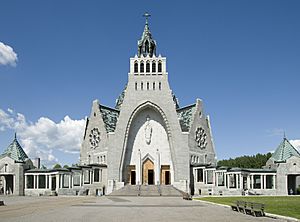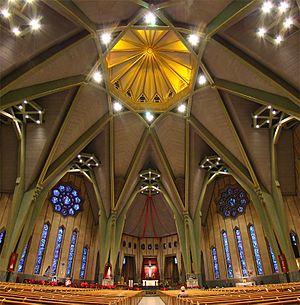Notre-Dame-du-Cap Basilica facts for kids
Quick facts for kids Notre-Dame-du-Cap Basilica |
|
|---|---|
| Basilica of Notre-Dame-du-Cap | |

Notre-Dame-du-Cap Basilica
|
|
| Location | Trois-Rivières, Quebec |
| Country | Canada |
| Denomination | Roman Catholic |
| History | |
| Status | Minor basilica |
| Architecture | |
| Functional status | Active |
| Architectural type | Norman-Gothic |
The Basilica of Notre-Dame-du-Cap is a very important church in Trois-Rivières, Quebec, Canada. It is Canada's special national shrine dedicated to the Virgin Mary. It is one of only six national shrines in the country. Every year, thousands of Catholic pilgrims visit this holy place.
Contents
History of the Basilica
Early Churches and Growth
The first church in Cap-de-la-Madeleine was a small wooden building. It was built way back in 1659. In 1694, the first priest, Father Paul Vachon, started a special group. This group was called the Confraternity of the Most Holy Rosary.
The wooden church was replaced by a new one made of stone in 1720. The strong wooden beams from the first church were used again. They became part of the new stone church. Father Vachon passed away in 1729 and is buried inside this church.
For a long time, the area did not have a full-time priest. The church was not used as much. But in 1867, Father Luc Desilets became the priest. He encouraged people to pray the rosary again. More people started coming to church. Soon, a bigger church was needed.
The Ice Bridge Miracle
Building a new church was hard because it was tough to bring materials. Then, in March 1879, something amazing happened. It was a mild winter, but a small part of the St. Lawrence River froze. Father Louis-Eugene Duguay and some helpers added snow and water. They built a narrow ice bridge, about one and a half miles long.
This ice bridge lasted for a whole week! It allowed building materials to be pulled across the river by horses. People believed this success was a gift from the Virgin Mary. In October 1880, the new, third church was finished. It was dedicated to Sainte-Marie-Madeleine.
A Promise Kept and a Shrine Begins
Father Desilets had made a promise to the Virgin Mary. Instead of tearing down the old stone church, he dedicated it to Our Lady, Queen of the Most Holy Rosary. The very first pilgrimage to this special place happened on May 7, 1883.
Father Desilets died soon after. Father Duguay then became the priest. Father Janssoone took over managing the shrine. He added a "Way of the Cross," which has bronze statues showing important moments. As more people visited, they asked the bishop for help. In 1902, the Missionary Oblates of Mary Immaculate became the guardians of the shrine.
Starting in 1906, they created a "Way of the Rosary." This path has bronze statues made in France. Each statue shows one of the fifteen traditional mysteries of the rosary.
Becoming a Basilica
In October 1904, Pope Pius X gave permission for a special crowning of Our Lady of the Cape. In 1964, the current, much larger basilica was opened. The shrine officially became a minor basilica. The Missionary Oblates of Mary Immaculate still take care of the shrine today.
Pope John Paul II visited the basilica in September 1984. Father Janssoone, who helped build the shrine, was declared "blessed" by Pope John Paul II on September 25, 1988.
Architecture of the Basilica
The church finished in 1888 was taken down in 1963. This made space for the large square in front of the current basilica. Some of its stones were saved. They were used in 1973 to add to the very first church building.
The current basilica was designed by architect Adrien Dufresne. It opened in 1964 and can hold up to 1,660 people. Strong concrete arches form the shape of the building.
The church has a huge Casavant organ with 5,425 pipes. The beautiful stained glass windows were created by a Dutch priest, Father Jan Tillemans.
See also
 In Spanish: Basílica de Nuestra Señora del Cabo (Trois-Rivières) para niños
In Spanish: Basílica de Nuestra Señora del Cabo (Trois-Rivières) para niños


